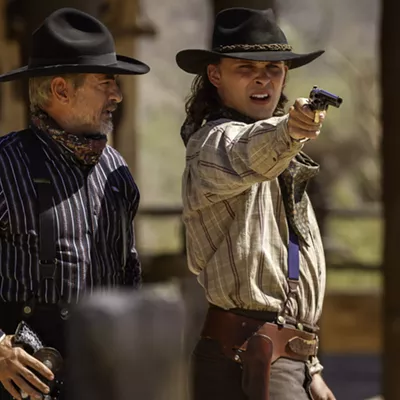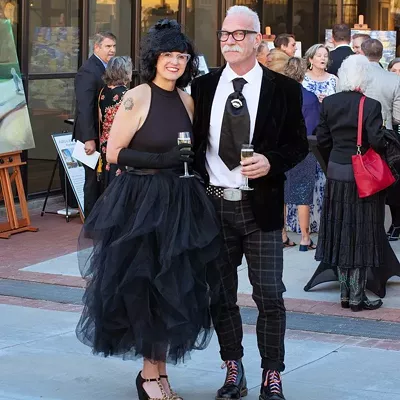In 2005, Arizona's worst year ever for migrant deaths, Lucrecia Dominguez Luna crossed the border near Sasabe.
She was traveling with her 15-year-old and 7-year-old sons in the brutal heat of June. "The Angel of Death awaited her in the Altar Valley," writes artist Deborah McCullough in a multimedia piece at the UA's Lionel Rombach Gallery, quoting Lucrecia's mother. "She died a horrific death in [her son's] arms, literally burned alive in the scorching Arizona desert."
The tragic story of Lucrecia's death and her father's search for her body is recounted in McCullough's "La Madre de Lucrecia." La madre herself frames the artwork: the 3-D piece is a sculpture of a Mexican woman draped in a black mourning shawl. Layers of cloth cover the woman's now-empty womb, and the viewer lifts piece after piece to read a text detailing the horrifying details of her daughter's end.
Lucrecia's father came from Mexico to search for her. After a month, he found her body in a wash, and identified her by the three rings that were still on the bones of her fingers. In the deepest reaches of McCullough's work lies a replica of her skeletal hand wearing three bands of gold.
As McCullough notes, Lucrecia is just one of thousands of border crossers who have perished in the Arizona desert. Between Oct. 1, 2000, and Sept. 30, 2014, 2,770 migrant bodies have been found. (The fiscal year just ended had the lowest toll in years: 121 bodies.) But these deaths are only the ones we know about; some of the dead turn to dust in the desert and their families never learn their fate.
McCullough has long hiked desert trails with the Tucson Samaritans to help migrants in distress, in hopes of staving off the deaths. And just as long, she has picked up the clothes and letters and photos they've left behind, and shaped them into heartbreaking works of art.
Installed for a short run timed to coincide with the Days of the Dead, her room-sized work, "Picking up the Pieces: Artifacts from the Migrants' Journey," grapples with the deadly tragedy. On the floor are dozens of shoes—baby sandals, flip-flops and high heels wildly inappropriate for the rocky migrant trail. They all head in one direction, evoking the surge of migrants north.
A length of wire has been strung on the walls like a clothesline, and the migrant belongings hanging there need no mediation by the artist. There's a pale blue baby dress adorned with lace, a love letter from a border crosser named Zara to a man named Miguel left behind. A child's drawing conjures up home, San Cristobal de las Casas in Chiapas, giving special attention to the route to Grandma's house.
One migrant dropped an official document from Eloy Detention Center. Evidently deported after his incarceration in Eloy, this migrant was attempting the journey north once again.
The Lucrecia work is one of eight shrines inspired by Mexican folk art and crafted of migrant artifacts. One honors child migrants. A baby doll dropped by a child has been placed in an arched wooden box, where it becomes a kind of patron saint of children in the wilderness. Another shrine honors young Josseline Hernandez Quinteros, a 14-year-old Salvadoran who died in Arizona's Tumacacori Highlands in 2008.
Holy cards bearing Josseline's picture are scattered across the top of the shrine; on the floor below are lime-green sneakers, just like the ones the young girl was wearing when she lost her life, a child on her way to join her mother in Los Angeles, (see "The Death of Josseline," Feb. 18, 2010).











